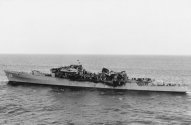I keep coming back to FFG-7 Perry, which was explicitly a budget program with compromises and cutbacks everywhere except to the suite of ASW capabilities that were the core task of the platform. Dual Seahawks were insisted upon for even this budget 054A-sized warship as that directly addressed the high-end and high-volume submarine threat that USN confronted in the late Cold War period. I believe that period and its challenges provide the best point of comparison for the challenges that PLAN faces today and going forward.
Contemporary USN is something of a mess (though, notably, a mess comprised largely of dual-helo combatants) while most of the other traditional naval powers that we may have looked at for comparison purposes are more or less in preservation mode, whether they admit it or not. Besides Cold War-era USN, JMSDF is probably the next-best example of a service that has long prioritised ASW. JMSDF of course has dedicated ASW helicopter carriers, but it also has 6000-tonne combatants (the Murusame/Takanami/Akizuki/Asahi series) with hangars that appear capable of accommodating two Seahawks, even if they only routinely deploy with one.
In any case 054B only has a single helo and there is no use complaining about it when there are many other interesting features to discuss or yet to be confirmed.
I keep thinking about the Perry as well, and to be honest the reason I think about it is just a reflection of how different the USN of then and the navies of today (including the PLAN today) are.
Frankly, the fact that the Perry was able to squeeze so many subsystems of the time, including dual helicopter hangars, into a 4000t hull was not only impressive, but probably not doable with the sort of requirements of today. I'm not only thinking about damage control, but also the complexity and size of modern subsystems (weapons and sensors), but also the expectations for crew facilities.
The Perry and its contemporary, the Spruance class which entered service at about the same era, were both ships with twin helicopter hangars where large parts of the USN surface combatant fleet outright lacked organic helicopter facilities. The Charles F Adams destroyers, and the cruisers of the era either had minimal helicopter accommodation facilities or outright lacked them. In many ways the Perry and Spruance could be seen as making up the deficiencies for the rest of the fleet of the time, while also orienting themselves for a more ASW role relative to the USN's other surface combatants.
The likes of the Marusume/Takanami/Akuzki/Asahi, as far as I can see, have a single enlarged hangar which can accommodate a 10 ton class helicopter and some extra equipment, but does not look able to actually accommodate two 10 ton helicopters side by side. The positioning of the helicopter secure/traverse system relative to the hangar on those ships certainly lends itself in a way that the recovered helicopter takes up 2/3rds of the overall width of the hangar space.
Finally, I think we should consider the PLAN's own past 2 hangar surface combatants in the modern/near modern era.
From the late cold war to now, the only PLAN surface combatants with 2 helicopter hangars are:
- original 052
- original 051B
- 055
I won't invoke the pictures of those three classes because we can look them up ourselves, however the geometry of those hangars and their widths I do not believe are equal, and that the hangar that 055 has (suited for Z-20F) is (at minimum) a little bit wider. Given Z-20F is a bit of a wider helicopter than the Z-9s that the original 052s and 051B would have been developed around, that makes sense.
My expectation, is that for the PLAN, if we want to consider the prospects of a proper twin helicopter hangar vessel, we should probably expect a 20m beam (near 055 beam) ship.
That said, I do think the 054B's hangar space could potentially be expanded a little bit in future variants, such as a miniature hangar to accommodate 1 or 2 smaller VT UAVs (which we know they are developing) on the side in addition to the main Z-20F hangar.
But I definitely don't think we should be viewing the helicopter hangar counts of PLAN surface combatants as if two should be a baseline expectation.
For a 18ish meter beam ship, I think one hangar is pretty reasonable.
For a 20ish meter beam ship, two hangars would be a more reasonable expectation at that scale. However even then, the French FREMM and US Constellation are also in that beam class and cannot accommodate two proper 10ton class helicopters either, so go figure.
Whenever the topic of helicopter hangar count comes up for new PLAN surface combatants (either new classes, or new batches of existing classes), I feel like there is a default expectation that PLAN surface combatants should come with two helicopter hangars, but I think people's reference scales are calibrated a bit incorrectly.

